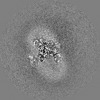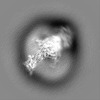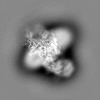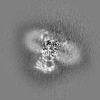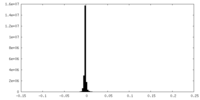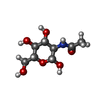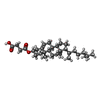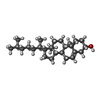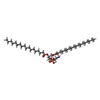[English] 日本語
 Yorodumi
Yorodumi- EMDB-23867: Human N-type voltage-gated calcium channel Cav2.2 in the presence... -
+ Open data
Open data
- Basic information
Basic information
| Entry | Database: EMDB / ID: EMD-23867 | |||||||||
|---|---|---|---|---|---|---|---|---|---|---|
| Title | Human N-type voltage-gated calcium channel Cav2.2 in the presence of ziconotide at 3.0 Angstrom resolution | |||||||||
 Map data Map data | ||||||||||
 Sample Sample |
| |||||||||
 Keywords Keywords | Cav2.2 / Channels / Calcium Ion-Selective / TRANSPORT PROTEIN-TOXIN complex / drugs | |||||||||
| Function / homology |  Function and homology information Function and homology informationpositive regulation of high voltage-gated calcium channel activity / regulation of membrane repolarization during action potential / Presynaptic depolarization and calcium channel opening / positive regulation of calcium ion-dependent exocytosis of neurotransmitter / calcium ion transmembrane transport via high voltage-gated calcium channel / high voltage-gated calcium channel activity / membrane depolarization during bundle of His cell action potential / L-type voltage-gated calcium channel complex / regulation of ventricular cardiac muscle cell membrane repolarization / host cell presynaptic membrane ...positive regulation of high voltage-gated calcium channel activity / regulation of membrane repolarization during action potential / Presynaptic depolarization and calcium channel opening / positive regulation of calcium ion-dependent exocytosis of neurotransmitter / calcium ion transmembrane transport via high voltage-gated calcium channel / high voltage-gated calcium channel activity / membrane depolarization during bundle of His cell action potential / L-type voltage-gated calcium channel complex / regulation of ventricular cardiac muscle cell membrane repolarization / host cell presynaptic membrane / NCAM1 interactions / cardiac muscle cell action potential involved in contraction / calcium ion transport into cytosol / regulation of calcium ion transmembrane transport via high voltage-gated calcium channel / voltage-gated calcium channel complex / Mechanical load activates signaling by PIEZO1 and integrins in osteocytes / ion channel inhibitor activity / regulation of heart rate by cardiac conduction / response to amyloid-beta / calcium ion import across plasma membrane / regulation of calcium ion transport / neuronal dense core vesicle / voltage-gated calcium channel activity / presynaptic active zone membrane / sarcoplasmic reticulum / protein localization to plasma membrane / calcium channel regulator activity / Regulation of insulin secretion / modulation of chemical synaptic transmission / GABA-ergic synapse / cellular response to amyloid-beta / Adrenaline,noradrenaline inhibits insulin secretion / calcium ion transport / T cell receptor signaling pathway / amyloid-beta binding / toxin activity / chemical synaptic transmission / neuronal cell body / calcium ion binding / synapse / extracellular exosome / extracellular region / ATP binding / metal ion binding / membrane / plasma membrane / cytosol Similarity search - Function | |||||||||
| Biological species |  Homo sapiens (human) / Homo sapiens (human) /  Conus magus (magus cone) Conus magus (magus cone) | |||||||||
| Method | single particle reconstruction / cryo EM / Resolution: 3.0 Å | |||||||||
 Authors Authors | Yan N / Gao S | |||||||||
| Funding support |  United States, 1 items United States, 1 items
| |||||||||
 Citation Citation |  Journal: Nature / Year: 2021 Journal: Nature / Year: 2021Title: Structure of human Ca2.2 channel blocked by the painkiller ziconotide. Authors: Shuai Gao / Xia Yao / Nieng Yan /  Abstract: The neuronal-type (N-type) voltage-gated calcium (Ca) channels, which are designated Ca2.2, have an important role in the release of neurotransmitters. Ziconotide is a Ca2.2-specific peptide pore ...The neuronal-type (N-type) voltage-gated calcium (Ca) channels, which are designated Ca2.2, have an important role in the release of neurotransmitters. Ziconotide is a Ca2.2-specific peptide pore blocker that has been clinically used for treating intractable pain. Here we present cryo-electron microscopy structures of human Ca2.2 (comprising the core α1 and the ancillary α2δ-1 and β3 subunits) in the presence or absence of ziconotide. Ziconotide is thoroughly coordinated by helices P1 and P2, which support the selectivity filter, and the extracellular loops (ECLs) in repeats II, III and IV of α1. To accommodate ziconotide, the ECL of repeat III and α2δ-1 have to tilt upward concertedly. Three of the voltage-sensing domains (VSDs) are in a depolarized state, whereas the VSD of repeat II exhibits a down conformation that is stabilized by Ca2-unique intracellular segments and a phosphatidylinositol 4,5-bisphosphate molecule. Our studies reveal the molecular basis for Ca2.2-specific pore blocking by ziconotide and establish the framework for investigating electromechanical coupling in Ca channels. | |||||||||
| History |
|
- Structure visualization
Structure visualization
| Movie |
 Movie viewer Movie viewer |
|---|---|
| Structure viewer | EM map:  SurfView SurfView Molmil Molmil Jmol/JSmol Jmol/JSmol |
| Supplemental images |
- Downloads & links
Downloads & links
-EMDB archive
| Map data |  emd_23867.map.gz emd_23867.map.gz | 78.3 MB |  EMDB map data format EMDB map data format | |
|---|---|---|---|---|
| Header (meta data) |  emd-23867-v30.xml emd-23867-v30.xml emd-23867.xml emd-23867.xml | 25.4 KB 25.4 KB | Display Display |  EMDB header EMDB header |
| Images |  emd_23867.png emd_23867.png | 116.2 KB | ||
| Filedesc metadata |  emd-23867.cif.gz emd-23867.cif.gz | 9.3 KB | ||
| Others |  emd_23867_additional_1.map.gz emd_23867_additional_1.map.gz | 77.9 MB | ||
| Archive directory |  http://ftp.pdbj.org/pub/emdb/structures/EMD-23867 http://ftp.pdbj.org/pub/emdb/structures/EMD-23867 ftp://ftp.pdbj.org/pub/emdb/structures/EMD-23867 ftp://ftp.pdbj.org/pub/emdb/structures/EMD-23867 | HTTPS FTP |
-Validation report
| Summary document |  emd_23867_validation.pdf.gz emd_23867_validation.pdf.gz | 569.4 KB | Display |  EMDB validaton report EMDB validaton report |
|---|---|---|---|---|
| Full document |  emd_23867_full_validation.pdf.gz emd_23867_full_validation.pdf.gz | 569 KB | Display | |
| Data in XML |  emd_23867_validation.xml.gz emd_23867_validation.xml.gz | 6.3 KB | Display | |
| Data in CIF |  emd_23867_validation.cif.gz emd_23867_validation.cif.gz | 7.2 KB | Display | |
| Arichive directory |  https://ftp.pdbj.org/pub/emdb/validation_reports/EMD-23867 https://ftp.pdbj.org/pub/emdb/validation_reports/EMD-23867 ftp://ftp.pdbj.org/pub/emdb/validation_reports/EMD-23867 ftp://ftp.pdbj.org/pub/emdb/validation_reports/EMD-23867 | HTTPS FTP |
-Related structure data
| Related structure data |  7mixMC  7miyC C: citing same article ( M: atomic model generated by this map |
|---|---|
| Similar structure data |
- Links
Links
| EMDB pages |  EMDB (EBI/PDBe) / EMDB (EBI/PDBe) /  EMDataResource EMDataResource |
|---|---|
| Related items in Molecule of the Month |
- Map
Map
| File |  Download / File: emd_23867.map.gz / Format: CCP4 / Size: 83.7 MB / Type: IMAGE STORED AS FLOATING POINT NUMBER (4 BYTES) Download / File: emd_23867.map.gz / Format: CCP4 / Size: 83.7 MB / Type: IMAGE STORED AS FLOATING POINT NUMBER (4 BYTES) | ||||||||||||||||||||||||||||||||||||||||||||||||||||||||||||||||||||
|---|---|---|---|---|---|---|---|---|---|---|---|---|---|---|---|---|---|---|---|---|---|---|---|---|---|---|---|---|---|---|---|---|---|---|---|---|---|---|---|---|---|---|---|---|---|---|---|---|---|---|---|---|---|---|---|---|---|---|---|---|---|---|---|---|---|---|---|---|---|
| Projections & slices | Image control
Images are generated by Spider. | ||||||||||||||||||||||||||||||||||||||||||||||||||||||||||||||||||||
| Voxel size | X=Y=Z: 1.114 Å | ||||||||||||||||||||||||||||||||||||||||||||||||||||||||||||||||||||
| Density |
| ||||||||||||||||||||||||||||||||||||||||||||||||||||||||||||||||||||
| Symmetry | Space group: 1 | ||||||||||||||||||||||||||||||||||||||||||||||||||||||||||||||||||||
| Details | EMDB XML:
CCP4 map header:
| ||||||||||||||||||||||||||||||||||||||||||||||||||||||||||||||||||||
-Supplemental data
-Additional map: #1
| File | emd_23867_additional_1.map | ||||||||||||
|---|---|---|---|---|---|---|---|---|---|---|---|---|---|
| Projections & Slices |
| ||||||||||||
| Density Histograms |
- Sample components
Sample components
+Entire : Cav2.2-ziconotide
+Supramolecule #1: Cav2.2-ziconotide
+Supramolecule #2: Cav2.2
+Macromolecule #1: Voltage-dependent N-type calcium channel subunit alpha-1B
+Macromolecule #2: Omega-conotoxin MVIIA
+Macromolecule #3: Voltage-dependent calcium channel subunit alpha-2/delta-1
+Macromolecule #4: Voltage-dependent L-type calcium channel subunit beta-3
+Macromolecule #8: 2-acetamido-2-deoxy-beta-D-glucopyranose
+Macromolecule #9: CALCIUM ION
+Macromolecule #10: CHOLESTEROL HEMISUCCINATE
+Macromolecule #11: CHOLESTEROL
+Macromolecule #12: 1,2-Distearoyl-sn-glycerophosphoethanolamine
+Macromolecule #13: [(2R)-1-octadecanoyloxy-3-[oxidanyl-[(1R,2R,3S,4R,5R,6S)-2,3,6-tr...
-Experimental details
-Structure determination
| Method | cryo EM |
|---|---|
 Processing Processing | single particle reconstruction |
| Aggregation state | particle |
- Sample preparation
Sample preparation
| Concentration | 20 mg/mL |
|---|---|
| Buffer | pH: 7.4 |
| Vitrification | Cryogen name: ETHANE / Chamber humidity: 100 % / Chamber temperature: 281 K / Instrument: FEI VITROBOT MARK IV / Details: blot for 6 seconds before plunging. |
| Details | Cav2.2-ziconotide |
- Electron microscopy
Electron microscopy
| Microscope | FEI TITAN KRIOS |
|---|---|
| Image recording | Film or detector model: GATAN K2 SUMMIT (4k x 4k) / Average electron dose: 50.0 e/Å2 |
| Electron beam | Acceleration voltage: 300 kV / Electron source:  FIELD EMISSION GUN FIELD EMISSION GUN |
| Electron optics | Illumination mode: FLOOD BEAM / Imaging mode: BRIGHT FIELD |
| Experimental equipment |  Model: Titan Krios / Image courtesy: FEI Company |
 Movie
Movie Controller
Controller




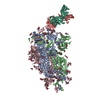
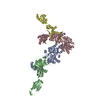
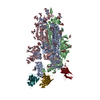


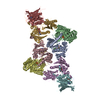
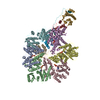
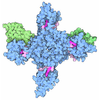


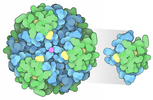



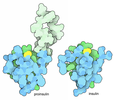
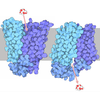
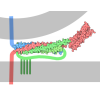
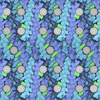
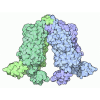
 Z (Sec.)
Z (Sec.) Y (Row.)
Y (Row.) X (Col.)
X (Col.)












